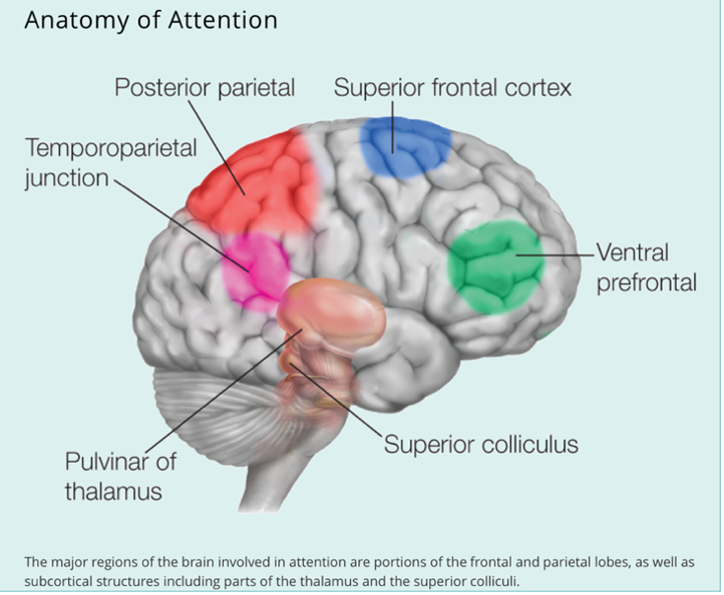There is no single location in the brain that is responsible for attention. More popular literature often refers to the formatio reticularis in the brainstem, but this is a neuromyth (Churches 2017:47; Kolb & Whishaw 2021:66). Attention involves several cortical and subcortical areas in our brain, as shown in Figure 1. These areas form networks, each responsible for a different aspect of attention.
¿Cómo funciona la atención en el cerebro?
(…) it is now possible to view attention much more concretely as an organ system, with its own functional anatomy and its own evolution and development. This system can be further broken down into at least three constituent networks.
– Posner (2012:1-2)
In 1949, Guiseppe Moruzzi and Horace Mongoun stimulated this area electrically in anesthetized cats. The stimulation produced a waking pattern of electrical activity in the cats’ cortices. The investigators concluded that the function of the reticular formation is to control sleeping and waking and to maintain “general arousal” or “consciousness”. As a result, the reticular formation came to be known as the reticular activating system. Damage to this area can result in permanent unconsciousness.
– Kolb & Whishaw (2021:66)
Three attentional networks
Michael Posner (1998, 2012), one of the world’s leading neuroscientists on the subject of attention, distinguishes three attention networks. Each of these networks is responsible for different attention processes:
- Red de alerta (when): this network is responsible for achieving and maintaining high sensitivity to incoming information
- Red de orientación (what): this network is responsible for selecting task-relevant information
- Red de atención ejecutiva (how): this network regulates the appropriate processing for a given task and monitors its execution.
Function: Alert
Co-activated brain structures:
- locus coeruleus (brainstem)
- frontal and parietal cortex
Modulator: Norepinephrine

Function: Orient
Co-activated brain structures:
- superior parietal cortex
- temporoparietal junction
- superior colliculi (brainstem)
Modulator: Acetylcholine

Function: Executive attention
Co-activated brain structures:
- ACC
- insula (anterior part)
- basal ganglia (prefrontal)
Modulator: Dopamine

Alerting, orienting, and executive control are widely thought to be relatively independent aspects of attention that are linked to separable brain regions. However, neuroimaging studies have yet to examine evidence for the anatomical separability of these three aspects of attention in the same subjects performing the same task.
– Fan et al. (2005:471)
Although each attentional network has its specific function and involves different brain structures and neurotransmitters, these three networks interact with each other in order to support learning (Callejas, Lupiánez & Tudela, 2004). Learning can be impaired if any of them is out of sync (Fan et al., 2009; Fan et al., 2005; Raz & Buhle, 2006). Lack of sleep (Mitru et al., 2002), difficulties in determining what is essential information and what is not, or inability to “resist” distractions (Levine, 2002) can cause problems with attention and learning.
Immordino-Yang (2011) found that an individual’s attention span for a given stimulus is directly related to the type and level of affect experienced. This means that when we’re interested in or enjoy a particular situation, we’ll be motivated to continue the activity and will learn faster and with less resistance than we would if we’d been faced with an unpleasant activity that caused us to feel ill at ease, bored, scared, frustrated, or threatened.
– Tokuhama-Espinosa (2014:125)
Nature or nurture?
Donald Hebb (1949) initially thought that most networks for complex functions, such as attention, developed primarily through experience. Recent research, however, seems to show that these attentional networks have a common architecture amongst individuals and thus must be coded in our DNA (Fan et al., 2001; Posner, 2011:25). Individual differences in the efficiency of attention networks can be explained by genetic variation. Not everyone is equally good at focusing attention, and not everyone can focus their attention on information for the same amount of time. Michael Posner has developed an Attention Network Test to examine the differences in the three attention networks in adults and children (Fan et al., 2002; Posner & Rothbart, 2005).
Límite de tiempo: 0
Resumen la prueba
0 de 4 preguntas completado
preguntas:
Información
Ya has completado el la prueba antes. Por lo tanto, no puede iniciarlo de nuevo.
la prueba está cargando…
Debes iniciar sesión o registrarte para iniciar el la prueba.
Primero debe completar lo siguiente:
Resultados
la prueba completas. Los resultados se están registrando.
Resultados
0 de 4 preguntas has respondido correctamente
Tu tiempo:
ha pasado el tiempo
Has alcanzado 0 de 0 punto(s), (0)
Punto(s) ganado(s): 0 de 0, (0)
0 Ensayo(s) Pendiente(s) (Punto(s) posible(s): 0)
Categorías
- No categorizado 0%
- 1
- 2
- 3
- 4
- Actual
- Revisar
- Contestada
- Correcto
- Incorrecto
-
Pregunta 1 de 4
1. Pregunta
1. The formatio reticularis is located in the brainstem is the centre of the attentional networks in our brain.
CorrectoIncorrecto -
Pregunta 2 de 4
2. Pregunta
2. Attention involves several cortical and subcortical areas in our brain.
CorrectoIncorrecto -
Pregunta 3 de 4
3. Pregunta
3. Match the attentional network with the appropriate function:
Ordenar elementos
- when
- what
- how
-
alerting network
-
orienting network
-
executive function network
CorrectoIncorrecto -
Pregunta 4 de 4
4. Pregunta
4. Your students’ attention span for a given stimulus is …
CorrectoIncorrecto
